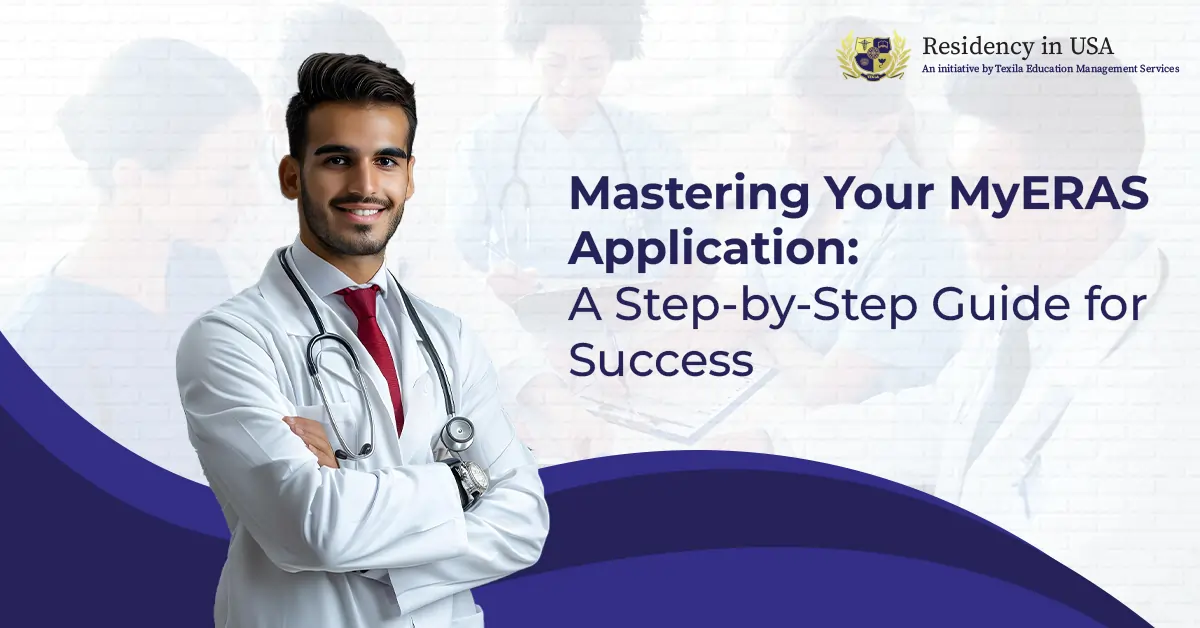Blog Summary
What is MyERAS?
MyERAS (Electronic Residency Application Service) is the online application system medical students and graduates use to apply for residency programs in the United States. Through MyERAS, applicants can submit their applications, personal statements, transcripts, letters of recommendation, and other required documents to multiple residency programs at once.
TEMS offers comprehensive Residency Application Services to help medical graduates navigate the MyERAS system and successfully apply to residency programs.
ERAS Timeline
Key Dates to Remember
June: Research programs using Residency Explorer, FREIDA, and ACGME. Review eligibility for ERAS, NRMP Match, and U.S. state medical licensure.
June 26: Obtain your ERAS Token from ECFMG’s OASIS and register on the MyERAS website. Begin submitting supporting documents.
September 4: Begin applying to residency programs at 9:00 a.m. ET.
September 16: NRMP Match registration opens.
September 25: Programs start accessing applications at 9:00 a.m. ET.
January 31 (2025): NRMP Match standard registration deadline (late fees apply after this date).
March 5 (2025): Deadline for NRMP Match registration and Rank Order List certification.
March 17-21 (2025): Match Week begins, culminating in Match Day.
May 31 (2025): MyERAS application closes.
July 1 (2025): Residency training begins.
Note: Always verify dates with the appropriate organizations.
Details and timelines are referenced from the official ECFMG website.
How to complete the Perfect MyERAS application
Personal Information: Accuracy and Consistency
Accurately filling out your personal and biographic information is crucial. Here is why:
- Correct Information: Ensure all details match your official documents to avoid any discrepancies that could delay your application.
- Double-check for Typos: Errors in your name, date of birth, or contact information can lead to misunderstandings and missed opportunities.
- Consistency is Key: Uniformity across all documents, including your MyERAS application, personal statement, and CV, reinforces your professionalism and attention to detail.

Curriculum Vitae (CV): Detailed Account of Educational Background
Your CV is vital components it stands out, focus on:
- Educational Achievements: List your medical school, degrees earned, and any honours or awards received.
- Publications and Training: Include any research publications and additional training programs you have completed.
- Roles and Responsibilities: Highlight your specific roles and accomplishments in various positions to give residency programs a clear picture of your capabilities and experience.
Personal Statement: Unique Story and Specialty Choice
Crafting a compelling personal statement is essential for success. Follow these guidelines:
- Tell Your Unique Story: Explain in your statement why you want to pursue a residency in the specialism of your choice. Talk about the experiences that have influenced your ambitions and career path.
- Adhere to Program Requirements: Different programs may have specific guidelines for the personal statement. Follow these requirements closely to maximize your chances of matching.
- Technical Guidelines: When drafting your statement outside the MyERAS application, use plain text word processing applications like Notepad (for Windows) or SimpleText (for Mac) to avoid formatting issues. The personal statement can be up to 28,000 characters, including letters, numbers, spaces, and punctuation.
Experiences
Updated Experiences Section: Now allows you to include up to 10 experiences, making it easier to highlight your comprehensive professional journey.
Including Up to 10 Experiences:
- List all relevant clinical, volunteer, research, and work experiences.
- Ensure each entry highlights your role, responsibilities, and achievements.
Highlighting the Three Most Meaningful Experiences
- Select the three experiences that have had the most significant impact on your career.
- Provide detailed insights into why these experiences are meaningful and how they shaped your professional path.
Letter(s) of Recommendation
Crucial Endorsements Letters of recommendation are a vital part of your MyERAS application, offering a professional endorsement of your skills and readiness for residency.
Process for Obtaining and Submitting Letters
- Request letters from mentors or supervisors who know your work well.
- Ensure each letter is personalized to reflect your strengths and suitability for the residency.
Creating Entries and Generating Letter IDs
- Create a separate entry for each letter in the MyERAS system.
- Once entered, each letter is assigned a unique Letter ID, which the writer then uses to upload the document.
USMLE/COMLEX-USA Transcripts
Inclusion of Exam Scores Including your USMLE and COMLEX-USA transcripts is crucial for your Electronic Residency Application Service application, as these scores are a vital factor in residency selection.
Importance of Transcripts in the Application
- Transcripts provide residency programs with a standardized measure of your medical knowledge and readiness.
- High scores can significantly enhance your application.
How to Include Them in the Application
- Request your transcripts through the appropriate official channels.
- Ensure they are sent directly to ERAS to be included in your application package.
Medical Student Performance Evaluation (MSPE)
The Medical Student Performance Evaluation (MSPE), also known as the Dean’s Letter. It provides a comprehensive and objective assessment of your medical school performance.
- Critical Points of MSPE:
- Objective Evaluation: The MSPE includes detailed evaluations of your academic performance, clinical skills, and professionalism.
- Dean’s Office Responsibility: Your Designated Dean’s Office uploads the MSPE to your Electronic Residency Application Service application.
- Automatic Submission: Once uploaded, the MSPE is automatically sent to all the residency programs you apply to. You do not need to assign it manually.
Medical School Transcript
Your medical school transcript is crucial for residency programs to evaluate your academic history and performance.
- Importance of Transcript:
- Academic Record: It provides a detailed account of your coursework, grades, and overall academic progress.
- Dean’s Office Upload: The Designated Dean’s Office uploads your transcript to MyERAS. Ensure they have the correct and updated version.
- Automatic Delivery: Similar to the MSPE, your transcript is automatically sent to all the programs you apply to, ensuring consistency and accuracy.
Photo
A professional photo is an often overlooked yet essential part. It helps residency programs give your application a face, making it more memorable.
- Photo Guidelines:
- Professional Headshot: Ensure your photo is clear, high-quality, and professionally presented to you.
- Specifications: The photo should be 2.5 inches x 3.5 inches, with a resolution of 150 dpi and a file size of 150kb.
- Self-Upload: You must upload your photo and ensure it meets the required standards.
Acing Residency Interviews: Tips for Building Your Rank Order List
After you receive interview invitations, take the time to research each residency program thoroughly. During your interviews, focus on highlighting your unique strengths and experiences.

Once you have completed your interviews, construct your rank order list thoughtfully, considering program culture, location, and training opportunities. A well-prepared rank order list will increase your chances of finding a residency program that fits your tastes and career ambitions.
Supplemental Offer and Acceptance Program (SOAP)
SOAP provides a list of programs with available spots, allowing you to apply directly through MyERAS. During this period, it is essential to promptly update your statement to reflect new experiences or changes in your interests.
Additionally, you can add new letters of recommendation to strengthen your application. By actively participating in SOAP and making these updates, you increase your chances of successfully matching into a residency program.
Application Certification and Submission Process
This step ensures that all information is accurate and complete, minimizing the risk of errors that could impact your residency application success. The submission you cannot make changes once it is certified. Therefore, double-check every detail to ensure accuracy and completeness.
Final Checklist Before Certifying and Submitting:
- Verify that all required fields are completed.
- For accuracy, review your personal information, CV, personal statement, and experiences.
- Confirm that your letters of recommendation, transcripts, and photos meet the specifications.
Following these steps enhances your chances of a successful residency match. For more MyERAS application tips, consider referencing a comprehensive ERAS guide to ensure you are fully prepared.
Your Path to Residency Starts Here: Best of Luck!
Mastering your MyERAS (Electronic Residency Application Service) application requires meticulous attention to detail and strategic preparation. You can significantly improve your chances of matching with a desired residency program by accurately completing each component, from personal information to your final submission.
Ensure you follow the ERAS timeline, adhere to specifications, and review all documents carefully before submission. Remember, a well-prepared application highlights your qualifications and reflects your commitment to the residency application process. Best of luck with your residency application!



